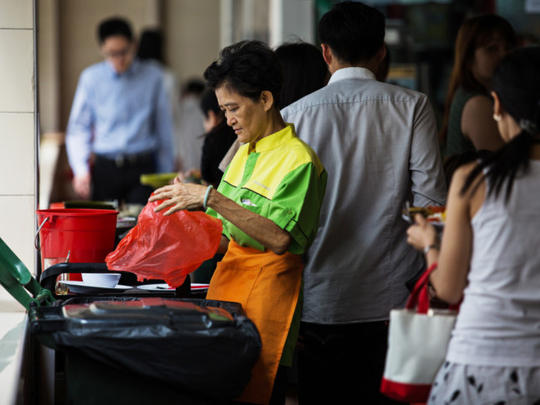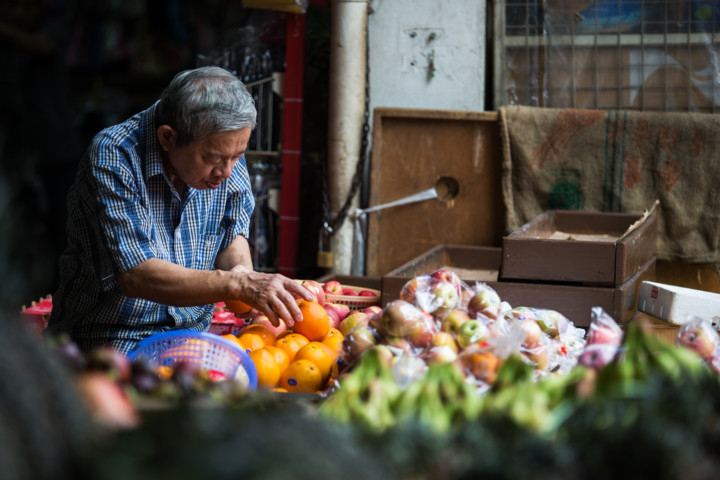
Everyone calls her Auntie Helen. At 69, she is one of the oldest employees at the food court at Raffles Place in Singapore, where office workers grab sandwiches and bowls of soba noodles in the lunchtime rush.
As she cleans and stacks cutlery, Helen Wong might seem to represent the workforce of the city’s past. For a government grappling with an ageing population, rising costs and curbs on immigration, her generation is the future.
“Food, transport, medicine are all more expensive now,” said Wong, who works seven hours a day, five days a week in the canteen-like basement, where diners can choose dishes from more than a dozen different vendors. “If I’m healthy and my body allows it, I’d like to work for as long as I’m able.”
In a culture that traditionally expects children to look after elderly parents, Singapore’s employment rate for those between ages 55 and 64 is now 66 per cent, among the highest of the 34 nations in the Organisation for Economic Co-operation and Development (OECD).
The government has made it mandatory for companies to offer three more years of work to those turning 62, the official retirement age, and plans to extend that to five years by 2017.
“The earlier mindset that having elderly people working indicates a lack of respect by younger people has changed,” said Theresa Devasahayam, editor of “Gender and Ageing: Southeast Asian Perspectives” and a visiting senior research fellow at the Asia Research Institute, National University of Singapore. “There are fewer children to take care of the elderly.”
The trend in Singapore is a microcosm of what’s happening across much of the developed world as families shrink and people live longer, increasing the strain on government pension systems.
South Korea, with the fastest-ageing population in the OECD, told employers to provide retirement plans for staff starting in 2016 after realising that its state pension fund may go broke by 2060, when its population over 65 is set to triple.
Germany and Britain plan to raise their retirement ages to 67 from 65, while Australian Treasurer Joe Hockey wants to increase the threshold to 70, the highest in the world.
Singapore has gone a step further. Rather than simply extending the working age, the government is encouraging companies to bring retirees back into the workforce. New registrations by those over 60 at state-run career centres, which help find jobs and retrain workers, almost doubled to 4,799 in 2013, from 2,494 in 2008.
“This is a huge change that has enormous social consequences that we haven’t fully grasped yet,” said Randolph Tan, an associate professor at SIM University in Singapore and a nominated member of parliament. “I’m not sure there’s much benefit to be had from raising the age any further.”
The push to hire older workers follows an attempt to increase the population by as much as 25 per cent by 2030 through immigration, a policy that prompted a public backlash as the arrival of migrants pushed up property prices and strained public transport. More than 40 per cent of the country’s population was born abroad.
Prime Minister Lee Hsien Loong responded by tightening rules for foreign workers, warning that the cost may be higher taxes over the next two decades. In his New Year statement on December 31, Lee said weak productivity gains for three straight years amid a labour crunch was “disappointing”.
“We need to employ all facets of labour of our very small workforce,” said Wai Ho Leong, a Singapore-based senior economist at Barclays, who was previously head of the trade and industry ministry’s microeconomics unit. “Society is better off when older people are active.”
To help address the labour shortfall, a committee for the employability of older workers unveiled an advertising campaign last year showcasing a 65-year-old lifeguard, a 76-year-old assistant inventory manager and a 60-year-old salmon filleter.
“Tap Into a Wealth of Experience,” exhorted an ad plastered across the side of a bus driving through the central shopping district, featuring a 58-year-old assistant front office manager at Raffles Hotel.
“Given the tight labour market situation, you actually would find many employers coming forward to say they’re willing to hire older workers,” Senior Minister of State for Manpower Amy Khor said in parliament in September.
Older workers have found jobs in companies including Hotel Royal Plaza on Scotts, Singapore General Hospital and ComfortDelGro, which runs the island’s biggest taxi service, according to the committee. The government in 2012 raised the age limit for taxi drivers to 75 from 73.
Singapore offsets part of the costs of hiring elderly workers and companies can tap government funds to redesign jobs and human resource systems for them. Older employees are especially useful for lower-skilled positions that otherwise might not be filled, said Leong at Barclays.
Cleaners, labourers and production and transport operators accounted for the highest numbers of older workers, according to a survey last year by Singapore-based DBS Bank. A majority of the elderly who were employed drew gross monthly incomes of less than S$1,500 (Dh4125), it showed.
“When you see elderly people cleaning the pavement in the middle of the day, you have to wonder if this is sustainable,” Devasahayam said. “It’s not practical to expect them to keep doing it; it’s cruel, there’s a moral dimension to it.”
Singapore has pledged to spend S$9 billion on health care and other benefits for the elderly in a so-called Pioneer Generation Package for about 450,000 citizens who were at least 16 years old in 1965, when the country gained independence.
About one fifth of Singapore’s employees over 55 work part time, such as Margaret Lee, who retrained after retiring from a childcare centre to work two days a week at a school cafeteria.
“It gives me something useful to do, and some extra money to spend,” said Lee, 62, whose husband is retired. Working part time allows her to help look after her grandchildren while their parents are at work.
By 2020, more than a third of Singapore’s population will be over 50, and by 2050 the nation’s median age will be 54, according to the committee on older workers, which includes representatives from government, business and trade unions.
“It has become essential to hire older workers because of the ageing population,” said Angelina Toh, co-founder of AJA Enterprises, which adapts buildings to withstand bomb blasts. She said her company employs them in supervisory and marketing roles where they adjust better than foreign workers. “They’re more mature emotionally, more independent,” Toh said.
Singaporean men live more than 20 years beyond the official retirement age on average and women 25 years, the longest out of the 68 countries in the Global Sunset Index released by Bloomberg Rankings in 2013. While retirees can draw from their pension savings at 55, at least S$155,000 must be kept in the account to provide a steady income stream.
Only one in five Singapore investors is confident their pension accounts will meet their retirement needs, with 47 per cent indicating the savings will be insufficient, according to a survey released in August by Toronto-based insurer Manulife Financial.
Auntie Helen says the money from her job in the food court covers her daily expenses and she enjoys chatting with her younger colleagues.
“What else is there for me to do, watch TV?” she said. “I was getting bored at home.”
–Washington Post














